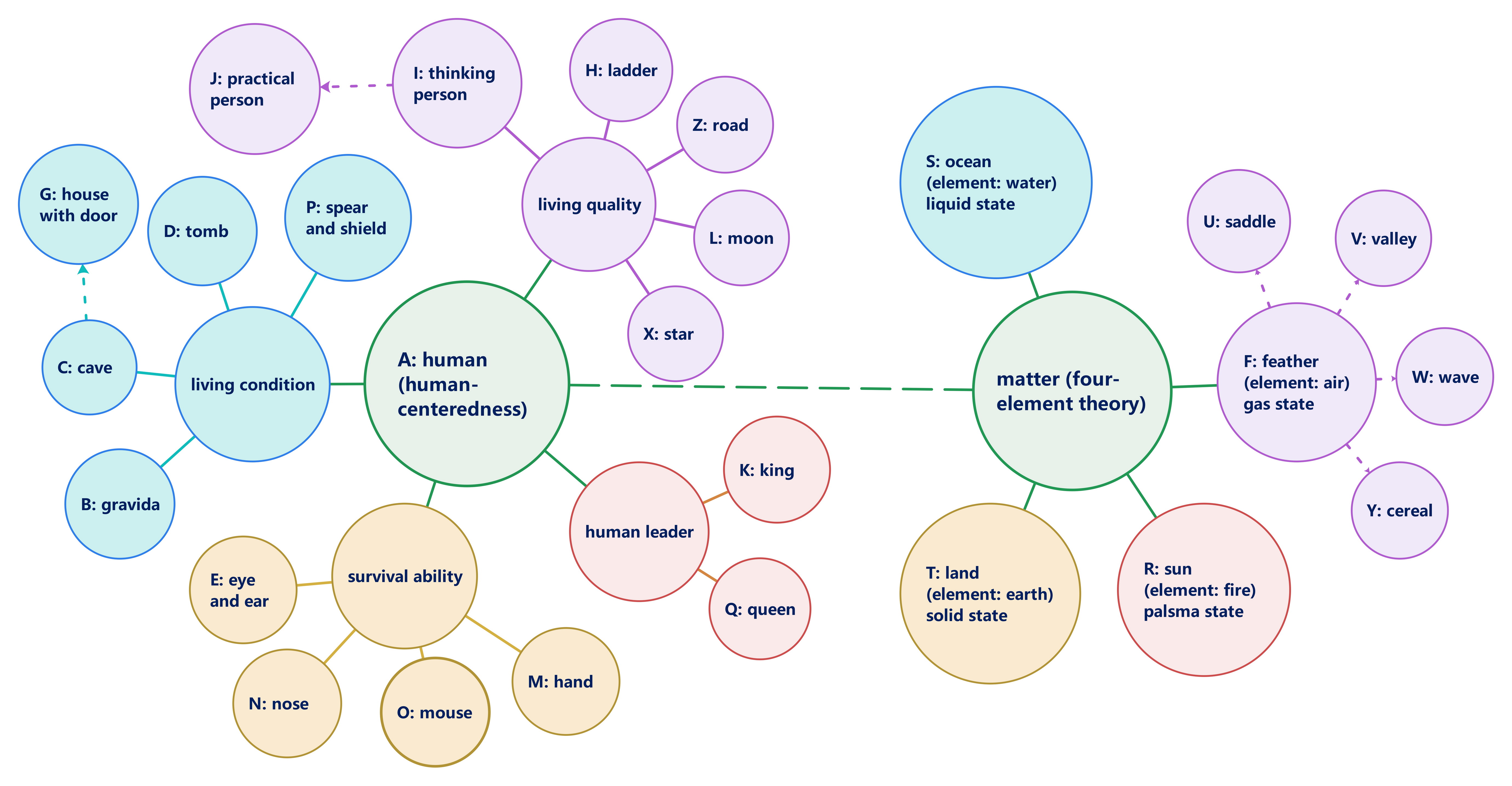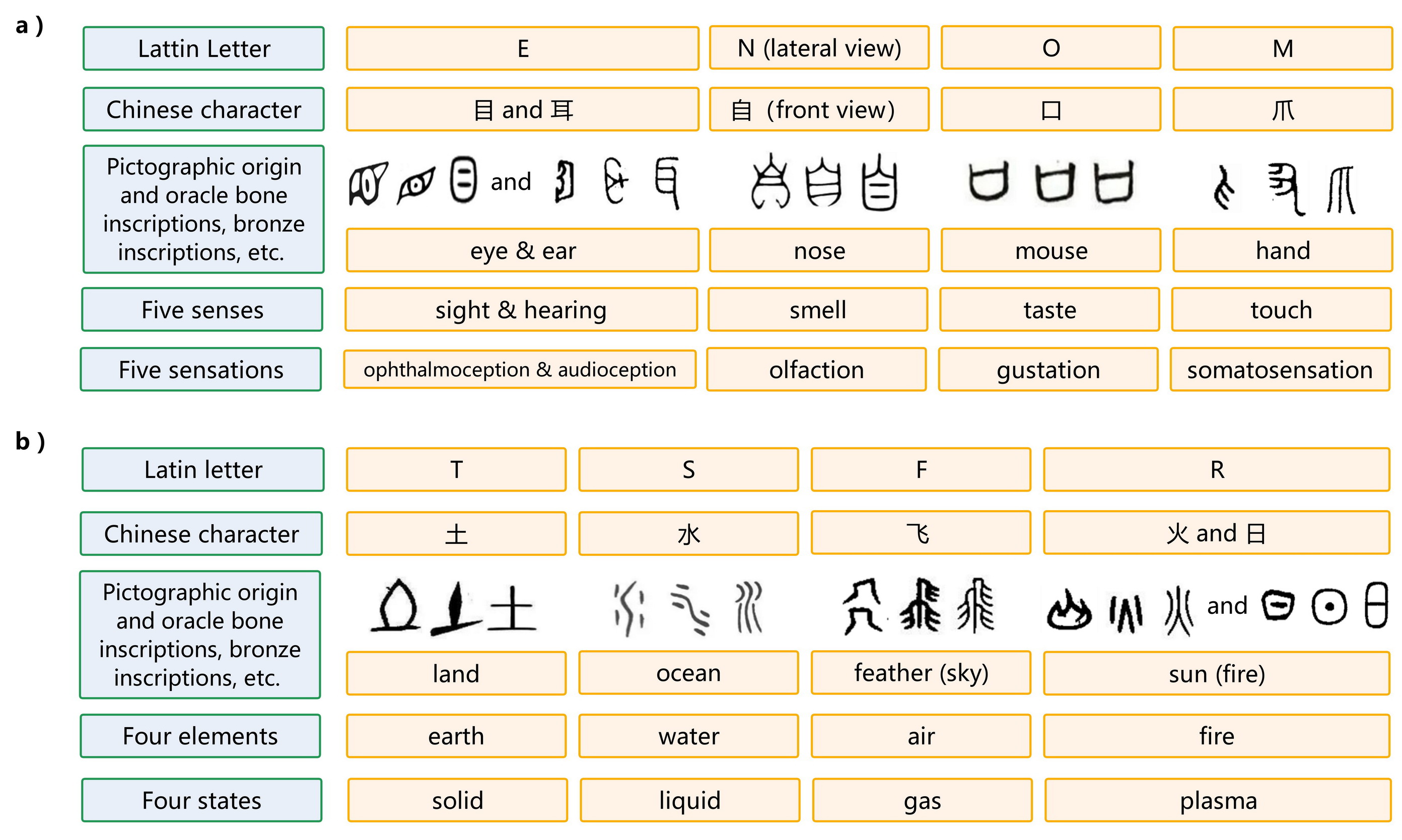博文
A new map for hieroglyphic origin of Latin alphabet
||
J&Y Latin letter theory: A new map for the hieroglyphic origin of 26 letters of the Latin alphabet
The origin of hieroglyphics comes from humans and nature.
J&Y Latin letter theory [1] has recently taken a novel approach to the study of the origins of the Latin alphabet, arguing that our understanding of the hieroglyphic meaning of the alphabet should be based directly on the study of that alphabet, rather than on Egyptian hieroglyphics or Phoenician and ancient Greek alphabets.
It argues that the 26-letter alphabet is systematic and logical, based on “human-centeredness” and “four elements theory” (Fig.1), with 18 human-centered letters and 8 letters representing the four elements.
Let us take the first Latin letter A as an example. The first letter in the Phoenician alphabet is “≮,” the ultimate source of which is the head or horns of a bull, but the ultimate source of the first letter “A” in the Latin alphabet is “human,” and its form resembles that of the Chinese character for “human” (人). Hence, the phonetics, form, and meaning of the letter A were all created based on human beings. As time went on, other meanings were derived from the original phonetics, form, and meaning of the letter A. For example, A has a pointed shape that looks like a bull’s horn, so it is not surprising that words such as angle and arrow developed. In addition, we find that simple words, letter combinations, roots, and affixes that contain the letter A are generally related to humans. It can be said that the form of the letter “A” not only retains some characteristics and meanings of the letter “≮,” but also take on new meanings.

Figure 1. Mind map of 26 Latin letters based on the concept of human-centeredness and four-element theory.
Based on the concept of human-centeredness, the 17 Latin letters except the letter A related to humans can be divided into four groups:
(1) The letters that represent human living conditions are B, C, D, and P, standing for pregnant women, caves, graves, and “spears and shields,” respectively. The letter G is a derivative of the letter C and denotes houses with a door.
(2) The letters representing the human ability to survive are E, N, O, and M, standing for eyes and ears, nose, mouth, and hands, respectively.
(3) The letters that represent the quality of human life are I, L, H, Z, and X, standing for thinking humans, ladders, roads, the moon, and stars, respectively. The letter J is a derivative of the letter I and denotes humans who do things.
(4) The letters K and Q represent kings and queens, respectively.
The eight Latin letters related to the four elements can be divided according to those elements:
(1) The letter T represents land and the element earth.
(2) The letter S represents ocean and the element water.
(3) The letter F represents feather and the element wind. The letters U, V, W, and Y are derivatives of the letter F, standing for saddles, valleys, ripples, and grain, respectively.
(4) The letter R represents sun and the element fire.
From a contemporary perspective, these elements represent the four states of matter – solid, liquid, gas, and plasma.
Coincidentally, many letters in the Latin alphabet resemble Chinese characters in both form and meaning, especially for the five sense organs of the human body and four fundamental elements of matter (Fig.2), including E and 目/耳 (eye/ear), O and 口 (mouth), M and 爪 (hand), T and 土 (earth), S and 水 (water), F and 飞 (fly), and R and 火 (fire), suggesting that they share the same hieroglyphic origin, but diverged over the course of their development.

Figure 2. Pictographic origin of Latin letters and Chinese characters related to the five sense organs of the human body and four fundamental elements of matter.
This new understanding of the origins of the Latin alphabet (i.e., J&Y Latin letter theory) will better facilitate the learning of languages (e.g., English, German, French, Spanish, etc.) that use that alphabet, particularly among learners and researchers whose mother tongue has Latin alphabet or a different writing system. Understanding the hieroglyphic origin of letters, and their phonetics, forms, and meanings, enables a more effective understanding of root words, prefixes, suffixes, and letter combinations. Changes in phonetics and form have also occurred to English words during their development, for which reference can be made to Grimm's Law and to the rules of changes in phonetics and form in Verner's Law.
Reference
Xiuli Jin, Feng Yu. Study on Ultimate Hieroglyphics Source of Twenty-Six Latin Letters in English from the Perspective of Human and Thing, Modern Linguistics, 2022, 10(1):119-129.
https://wap.sciencenet.cn/blog-43496-1325299.html
上一篇:英语学习的相关“必备资料”:金鱼拉丁字母理论、牛津词典、格林法则和维尔纳定律、逻辑英语语法、听说读写相关资料
下一篇:“破五唯”中的辩证关系浅析——“不拘一格降人才”——破除“唯论文、唯帽子、唯职称、唯学历、唯奖项”